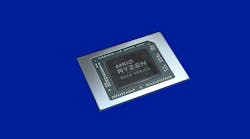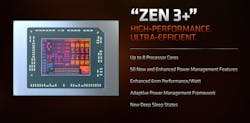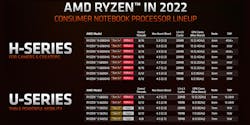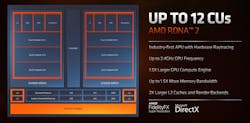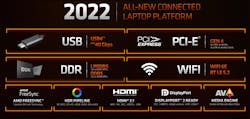AMD Keeps Pressure on Intel With New Mobile Processors for PCs
Check out our CES 2022 coverage.
AMD is stepping up its effort to take on Intel in the personal-computer market with a new line of central processing chips for laptops that deliver big leaps in computer processing and graphical performance.
The Santa Clara, California-based company said the Ryzen 6000 series of mobile CPUs, code-named Rembrandt, offers significant performance and battery-life improvements thanks to its new Zen 3+ CPU architecture, including better power-management features and the increased horsepower of AMD’s RDNA 2 graphics technology.
The new chips, which CEO Lisa Su introduced at the Consumer Electronics Show (CES), supply up to 11% faster single-thread and up to 28% more multi-threaded performance than its previous generation.
The new processors succeed its Ryzen 5000 line of laptop chips announced last year at CES. The family spans 10 devices with power envelopes ranging from 15W and 28W in its Ryzen U-series CPUs for thin, portable laptops to 35 W and 45 W in its Ryzen H-series for high-end models ideal for productivity tasks and gaming.
Under the Hood
AMD has been mounting its most ambitious assault on Intel’s dominance in PCs in more than a decade, stealing market share with chips that match or defeat Intel’s on performance benchmarks. AMD is trying to keep the pressure on with the new Ryzen 6000 series for laptops.
Intel is trying to strike back with its new generation of PC chips, code-named Alder Lake, which boosts performance by high-performance and energy-efficient cores in a way that resembles Arm's big.LITTLE technology.
The chips are manufactured by TSMC on the 6-nm node, which wrings out more performance and efficiency over the 7-nm node used in the previous Ryzen 5000 series. At the heart of the Ryzen 6000 series is AMD’s new Zen 3+ architecture. It improves the power efficiency of Zen 3 cores introduced in 2020, while keeping them cooler. AMD said the chips would use up to 40% less power for streaming video and other chores.
The Zen 3+ architecture brings 50 enhanced power-management features into the fold. It also adds adaptive power management that adjusts the processor’s speed more efficiently than before as well as deep-sleep states. This translates to an increase from 21 to 24 hours of maximum battery life while playing video, AMD said.
“AMD is the only team that can deliver a performance core and an efficient core in the same core,” said Jason Banta, corporate vice president and general manager of the PC OEM business at AMD, during CES.
Clock Speed Boost
At the top of the product line, the Ryzen HX-Series processors pump out more performance for productivity tasks on high-end laptops with larger displays and physical keyboards with bolstered graphics for gaming. It is also rolling out U-series CPUs for ultra-portable laptops and post-clamshell models, such as detachable tablets that snap onto keyboards and “2-in-1” laptops with 360-degree hinges that fold into a tablet form.
Also on tap is a reinvigorated line of Ryzen 5000 mobile processors based on its Zen 3 cores for 2022.
The flagship of the lineup is the Ryzen 9 6980HX. It contains eight CPU cores based on AMD’s Zen 3+ architecture clocked at a base frequency of 3.3 GHz and a boosted maximum speed of 5 GHz. The processor packs 12 graphics cores with a maximum boost speed of 2.4 GHz, and 20 MB of cache memory. Every CPU core can process a pair of instructions at the same time, offering the possibility of running up to 16 threads.
Su said the 5-GHz max clock speed makes these Ryzen processors the company’s fastest to date.
Graphics Upgrade
The Zen 3 cores are complemented by the increased horsepower of AMD’s RDNA 2 graphics architecture, which is used in high-end game consoles such as the Microsoft Xbox Series X and Sony’s PlayStation 5. RDNA 2 is also under the hood of its latest Radeon graphics processing units (GPUs) for desktop computers.
The integrated graphics in the Ryzen 6000 Series include up to 12 compute units, a 50% increase from the Ryzen 5000 CPUs, which contained up to 10 compute units based on AMD’s Vega graphics architecture. AMD noted that it also re-engineered the graphics engine at the heart of the laptop chips: It doubled the cache memory inside and added hardware-accelerated ray tracing, among other improvements.
AMD said the Ryzen 6000 series brings up to 2.1 times more graphical performance than the Ryzen 5000 series, generating more realistic images for gaming or other graphics-heavy workloads such as designing a product in three dimensions. According to AMD, the chips also include a new integrated display engine, allowing for ultra-high resolutions and refresh rates.
The chips wring out more performance using AMD’s Fidelity FX Super Resolution (FSR) software, which intelligently sharpens images while preserving as much detail as possible to run games at faster frame rates.
Furthermore, AMD increased the clock frequency of its integrated graphics from 2.0 GHz to 2.4 GHz.
Security and Connectivity
AMD said the Ryzen CPUs are the first to integrate Microsoft’s new Pluton security processor, beating out Intel. Pluton is baked directly into the CPU, giving it more protection against software and hardware attacks.
The Ryzen 6000 mobile CPUs contain DDR5-5200 and LPDDR5-6400 memory subsystems, which the company said will support a big boost in memory bandwidth over its previous generation of chips with DDR4 and LPDDR4. The chips support USB4, delivering data-transfer rates of up to 40 GB/s, and HDMI 2.0 and DisplayPort 2.1 display standards. AMD also upgraded the chips from PCIe Gen 3 to PCIe Gen 4.
AMD said that personal-computer companies plan to use the new Ryzen 6000 mobile processors, and its previous Ryzen 5000 series chips, in about 200 laptop models in 2022, up from 150 the year before.
AMD has partnered with Lenovo to supply chips for a premium line of business laptops called ThinkPad Z. The company said Dell Technologies, HP, and others will also introduce PCs based on the new chips.
